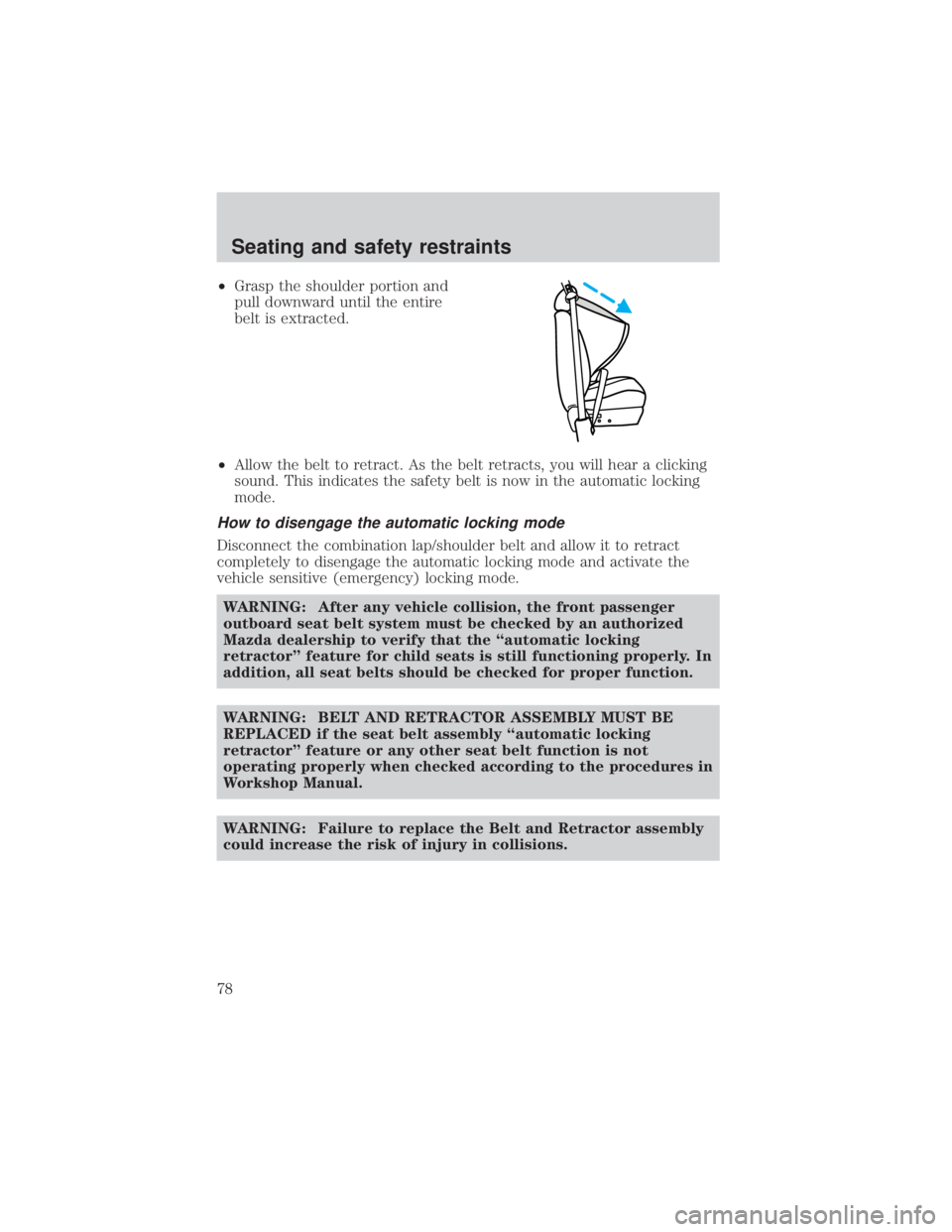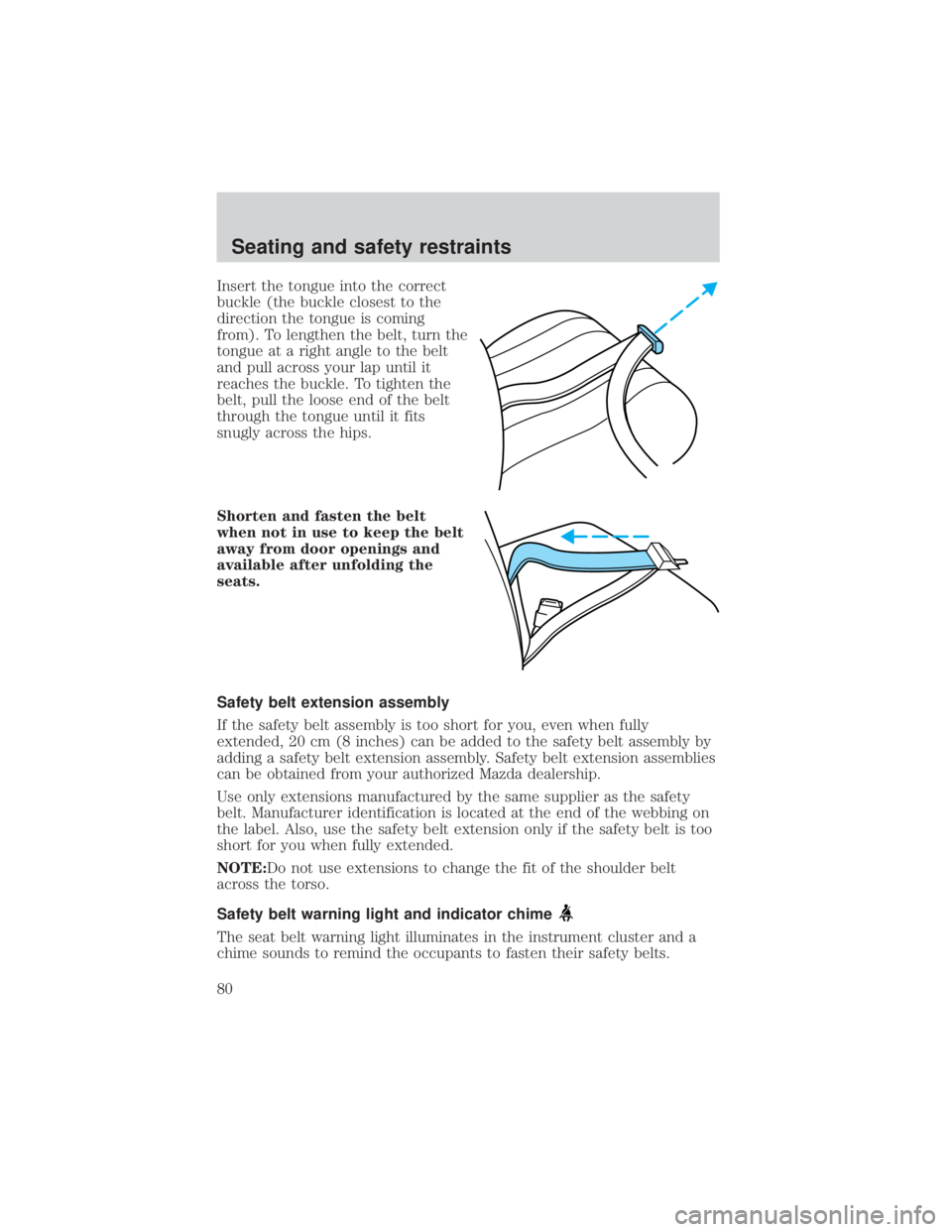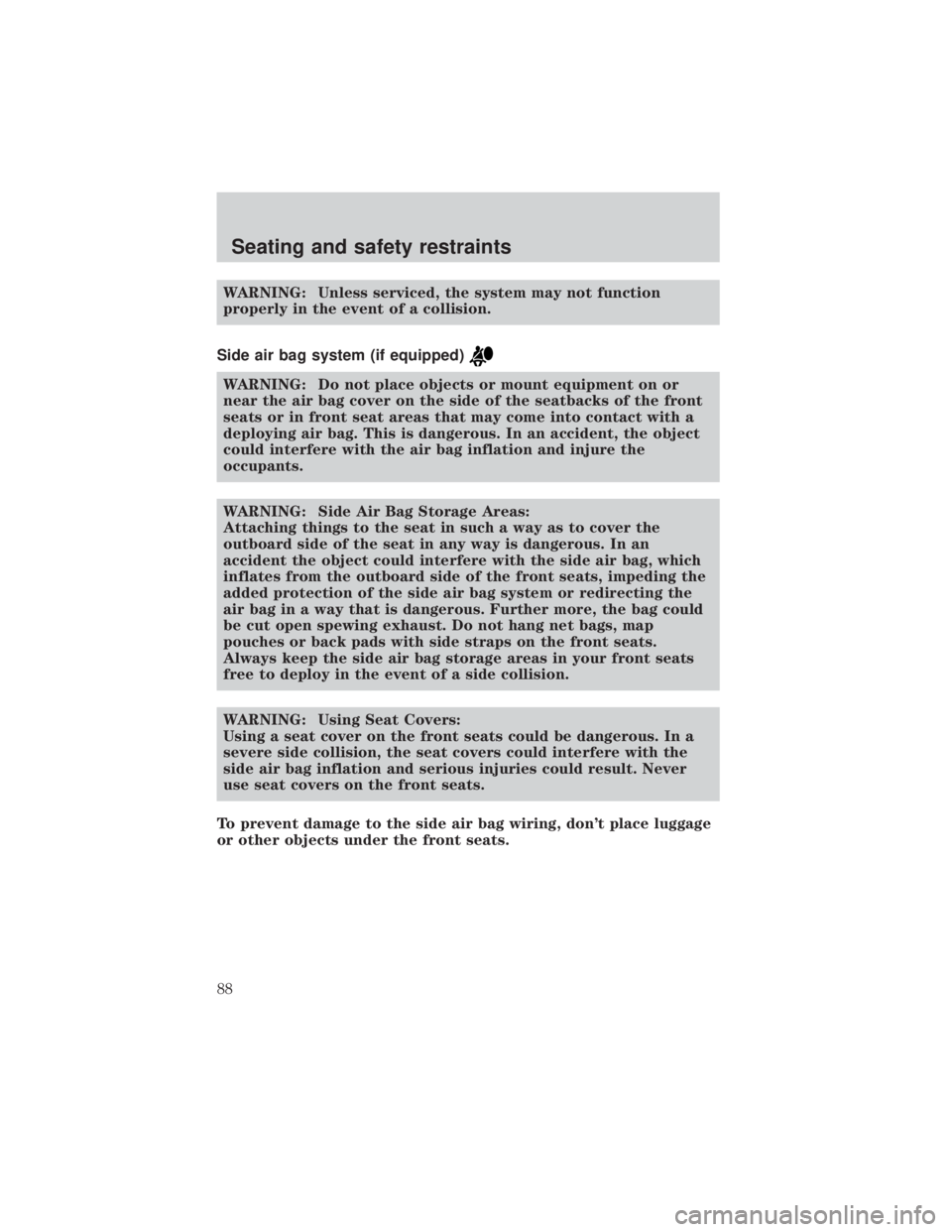2001 MAZDA MODEL TRIBUTE 4WD seats
[x] Cancel search: seatsPage 78 of 232

²Grasp the shoulder portion and
pull downward until the entire
belt is extracted.
² Allow the belt to retract. As the belt retracts, you will hear a clicking
sound. This indicates the safety belt is now in the automatic locking
mode.
How to disengage the automatic locking mode
Disconnect the combination lap/shoulder belt and allow it to retract
completely to disengage the automatic locking mode and activate the
vehicle sensitive (emergency) locking mode.
WARNING: After any vehicle collision, the front passenger
outboard seat belt system must be checked by an authorized
Mazda dealership to verify that the ªautomatic locking
retractorº feature for child seats is still functioning properly. In
addition, all seat belts should be checked for proper function.
WARNING: BELT AND RETRACTOR ASSEMBLY MUST BE
REPLACED if the seat belt assembly ªautomatic locking
retractorº feature or any other seat belt function is not
operating properly when checked according to the procedures in
Workshop Manual.
WARNING: Failure to replace the Belt and Retractor assembly
could increase the risk of injury in collisions.
Seating and safety restraints
78
Page 80 of 232

Insert the tongue into the correct
buckle (the buckle closest to the
direction the tongue is coming
from). To lengthen the belt, turn the
tongue at a right angle to the belt
and pull across your lap until it
reaches the buckle. To tighten the
belt, pull the loose end of the belt
through the tongue until it fits
snugly across the hips.
Shorten and fasten the belt
when not in use to keep the belt
away from door openings and
available after unfolding the
seats.
Safety belt extension assembly
If the safety belt assembly is too short for you, even when fully
extended, 20 cm (8 inches) can be added to the safety belt assembly by
adding a safety belt extension assembly. Safety belt extension assemblies
can be obtained from your authorized Mazda dealership.
Use only extensions manufactured by the same supplier as the safety
belt. Manufacturer identification is located at the end of the webbing on
the label. Also, use the safety belt extension only if the safety belt is too
short for you when fully extended.
NOTE:Do not use extensions to change the fit of the shoulder belt
across the torso.
Safety belt warning light and indicator chime
The seat belt warning light illuminates in the instrument cluster and a
chime sounds to remind the occupants to fasten their safety belts.
Seating and safety restraints
80
Page 88 of 232

WARNING: Unless serviced, the system may not function
properly in the event of a collision.
Side air bag system (if equipped)
WARNING: Do not place objects or mount equipment on or
near the air bag cover on the side of the seatbacks of the front
seats or in front seat areas that may come into contact with a
deploying air bag. This is dangerous. In an accident, the object
could interfere with the air bag inflation and injure the
occupants.
WARNING: Side Air Bag Storage Areas:
Attaching things to the seat in such a way as to cover the
outboard side of the seat in any way is dangerous. In an
accident the object could interfere with the side air bag, which
inflates from the outboard side of the front seats, impeding the
added protection of the side air bag system or redirecting the
air bag in a way that is dangerous. Further more, the bag could
be cut open spewing exhaust. Do not hang net bags, map
pouches or back pads with side straps on the front seats.
Always keep the side air bag storage areas in your front seats
free to deploy in the event of a side collision.
WARNING: Using Seat Covers:
Using a seat cover on the front seats could be dangerous. In a
severe side collision, the seat covers could interfere with the
side air bag inflation and serious injuries could result. Never
use seat covers on the front seats.
To prevent damage to the side air bag wiring, don't place luggage
or other objects under the front seats.
Seating and safety restraints
88
Page 89 of 232

WARNING: Seating Position with Side Air Bags
Sitting too close to the side air bag storage compartments or
placing hands on them is extremely dangerous. A side air bag
inflates with great force and speed directly out of the outboard
shoulder of the front seat and expands along the front door on
the side the car is hit. Serious injury could occur if someone is
sitting too close to the door or leaning against a window in the
front seats or if rear seat occupants grab the sides of the front
seatbacks. Furthermore, sleeping up against the door or
hanging out the driver's-side window while driving could block
the side air bag and eliminate the advantages of supplemental
protection. Give the side air bags room to work by sitting in the
center of the seat while the vehicle is moving with seat belts
worn properly.
WARNING: Modification of the Supplemental Restraint System
Modifying the components or wiring of the supplemental
restraint system is dangerous. You could accidentally activate it
or make it inoperable. Don't make any modifications to the
supplemental restraint system. This includes installing trim,
badges, or anything else over the air bag storage areas. It also
includes installing extra electric equipment on or near system
components or wiring.
An Authorized Mazda Dealer can provide the special care
needed in the removal and installation of front seats. It is
important to protect the side air bag wiring and connections to
assure that the bags do not accidently deploy and that the seats
retain an undamaged air bag connection.
WARNING: Do not attempt to service, repair, or modify the air
bag Supplemental Restraint System, its fuses or the seat cover
on a seat containing an air bag. See your authorized Mazda
dealer.
WARNING: All occupants of the vehicle including the driver
should always wear their safety belts even when an air bag SRS
is provided.
Seating and safety restraints
89
Page 90 of 232

How does the side air bag system work?
The side air bag system consists of
the following:
²An inflatable nylon bag (air bag)
with a gas generator concealed
behind the outboard bolster of
the driver and front passenger
seatbacks.
² A special seat cover designed to
allow airbag deployment.
² The same warning light,
electronic control and diagnostic
unit as used for the front air
bags.
² The two side sensors are located
on the lower portion of the
b-pillar.
NOTE:A side air bag, in combination with seat belts, can help reduce
the risk of severe injuries in the event of a significant side impact
collision.
The side air bags are fitted on the outboard side of the seatbacks of the
front seats. In certain lateral collisions, the air bag on the side affected
by the collision will be inflated, even if the respective seat is not
occupied. The air bag was designed to inflate between the door panel
and occupant to further enhance the protection provided occupants in
side impact collisions.
The air bag SRS is designed to activate when the vehicle sustains lateral
deceleration sufficient to cause the sensors to close an electrical circuit
that initiates air bag inflation.
The fact that the air bags did not inflate in a collision does not mean that
something is wrong with the system. Rather, it means the forces were
not of the type sufficient to cause activation. Side air bags are designed
to inflate in side-impact collisions, not roll-over, rear-impact, frontal,
near-frontal or opposite side collisions, unless the collision causes
sufficient lateral deceleration.
Seating and safety restraints
90
Page 92 of 232

Disposal of air bags and air bag equipped vehicles
For disposal of air bags or air bag equipped vehicles, see your authorized
Mazda dealership. Air bags MUST BE disposed of by qualified personnel.
SAFETY RESTRAINTS FOR CHILDREN
See the following sections for directions on how to properly use safety
restraints for children. Also seeAir Bag Supplemental Restraint System
(SRS) in this chapter for special instructions about using air bags.
Important child restraint precautions
NOTE:You are required by law to use safety restraints for children in the
U.S. and Canada. If small children ride in your vehicle (generally children
who are four years old or younger and who weigh 18 kg [40 lbs] or less),
you must put them in safety seats made especially for children. Check
your local and state or provincial laws for specific requirements
regarding the safety of children in your vehicle.
WARNING: Never let a passenger hold a child on his or her lap
while the vehicle is moving. The passenger cannot protect the
child from injury in a collision.
NOTE:Always follow the instructions and warnings that come with any
infant or child restraint you might use. WARNING: When possible, always place children under age 12
in the rear seat of your vehicle. Accident statistics suggest that
children are safer when properly restrained in the rear seating
positions than in the front seating position.
Children and safety belts
If the child is the proper size, restrain the child in a safety seat.
Children who are too large for child safety seats (as specified by your
child safety seat manufacturer) should always wear safety belts.
Follow all the important safety restraint and air bag precautions that
apply to adult passengers in your vehicle.
If the shoulder belt portion of a combination lap and shoulder belt can be
positioned so it does not cross or rest in front of the child's face or neck,
the child should wear the lap and shoulder belt. Moving the child closer to
the center of the vehicle may help provide a good shoulder belt fit.
Seating and safety restraints
92
Page 93 of 232

WARNING: Do not leave children, unreliable adults, or pets
unattended in your vehicle.
To improve the fit of lap and shoulder belts on children who have
outgrown child safety seats, Mazda recommends use of a belt-positioning
booster seat that is labelled as conforming to all applicable Federal motor
vehicle safety standards. Belt-positioning booster seats raise the child
and provide a shorter, firmer seating cushion that encourages safer
seating posture and better fit of lap and shoulder belts on the child.
A belt-positioning booster should be used if the shoulder belt rests in
front of the child's face or neck, or if the lap belt does not fit snugly on
both thighs, or if the thighs are too short to let the child sit all the way
back on the seat cushion when the lower legs hang over the edge of the
seat cushion. You may wish to discuss the special needs of your child
with your pediatrician. WARNING: Placing a child, 12 years or younger, in the front
seat is dangerous. The child could be hit by a deploying air bag
and be seriously injured or even killed. A sleeping child is more
likely to lean against the door and be hit by the side air bag in a
moderate collision. Whenever possible, always secure a child, 12
years or younger, in the rear seat, with an appropriate child
restraint system for the child's age and size. Never use a
rear-facing child restraint system in the front seat with an air
bag that could deploy.
SAFETY SEATS FOR CHILDREN
Seating and safety restraints
93
Page 94 of 232

Child and infant or child safety seats
Use a safety seat that is recommended for the size and weight of the
child. Carefully follow all of the manufacturer's instructions with the
safety seat you put in your vehicle. If you do not install and use the
safety seat properly, the child may be injured in a sudden stop or
collision.
When installing a child safety seat:
²Review and follow the information
presented in the Air Bag
Supplemental Restraint
Systemsection in this chapter.
² Use the correct safety belt buckle
for that seating position (the
buckle closest to the direction the
tongue is coming from).
² Insert the belt tongue into the
proper buckle until you hear a
snap and feel it latch. Make sure
the tongue is securely fastened in
the buckle.
² Keep the buckle release button
pointing up and away from the
safety seat, with the tongue
between the child seat and the
release button, to prevent accidental unbuckling.
² Place seat back in upright position.
² Put the safety belt in the automatic locking mode. Refer to Automatic
locking mode (passenger side front seat).
Mazda recommends the use of a child safety seat having a top tether
strap. Install the child safety seat in a seating position which is capable
of providing a tether anchorage. For more information on top tether
straps, refer to Attaching child safety seats with tether straps.
WARNING: Carefully follow all of the manufacturer's
instructions included with the safety seat you put in your
vehicle. If you do not install and use the safety seat properly,
the child may be injured in a sudden stop or collision.
Seating and safety restraints
94